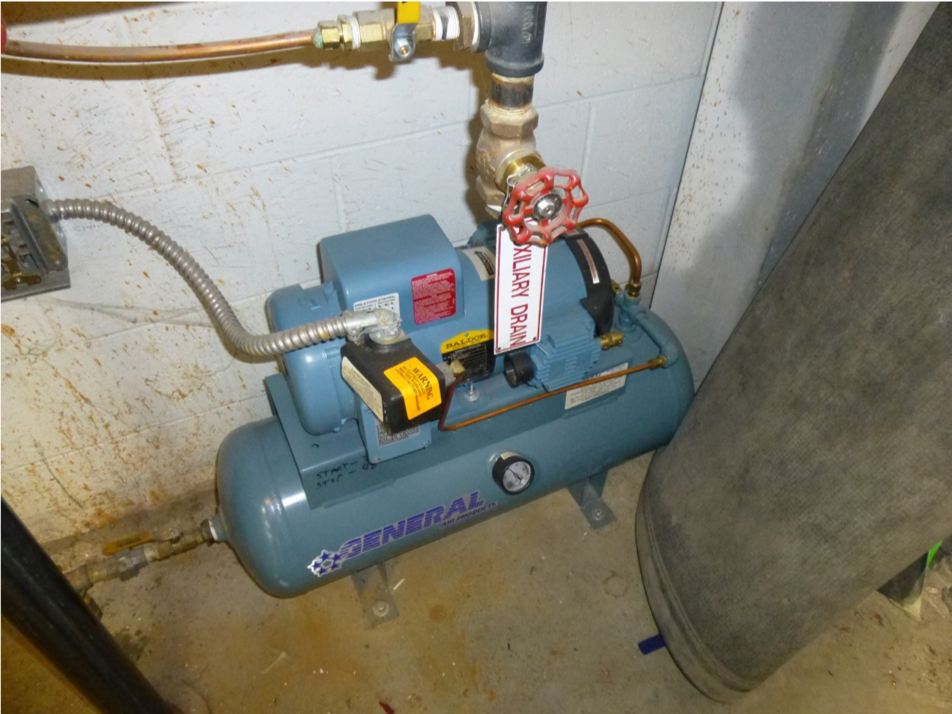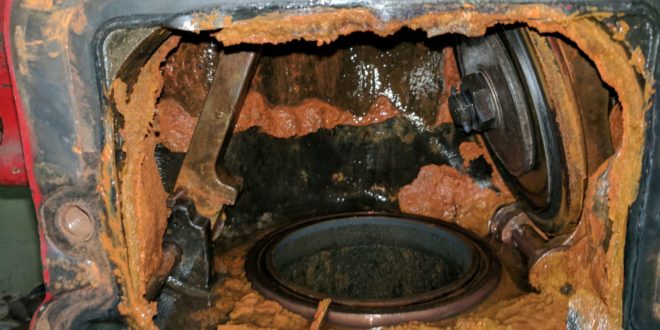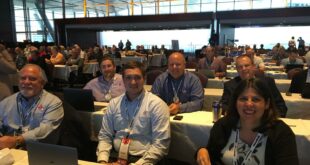“Air” on the Side of Caution
If you are a reader of Sprinkler Age from front to back and not just one who subscribes for the pictures or gossip column, then you’ve seen the article
We all know that the systems most devastated by corrosion are the systems with closed dry piping (dry/preaction systems). With the emergence and availability of nitrogen, air dryers, and other systems these days, we’ve solved the corrosion issue, correct? Well no, there are a few things that are working against us. Without a major catastrophic incident, most building owners couldn’t care less about the condition of their sprinkler system. The fire sprinkler, or any life-safety system for that matter, is not missed until it’s needed – whoops! Apparently, the cost of these preventative systems is more than what our customers are comfortable with or willing to pay. Often, fire sprinkler systems are designed, built, and forgotten – let alone is there an incentive to upgrade even after costly repairs. The investment in preventative maintenance has not quite reached that unspecified encumbrance to tip the scale. As usual, here we are at an ITM crossroads faced with what we should be able to do and what is available to us, versus the reality of customer budgets and contracts. And folks, after speaking with my 401(k) guy (“my” as in me and 5,000 other zhlubs), the forecast is not looking any better.
So, good for the customer for staying on track with their dry system valve trip tests. Good for our well-trained techs, also, for doing a thorough inspection and test of the dry system valve and the associated trim and piping. But like Paul Harvey said, “Now for the rest of the story…” – there is more to do, and little time and money to do it. What is often missed is the why, how, and what’s next that our technicians often fail to explain to the building owners. It’s not that the techs don’t care, but that the full picture has not been divulged to them, either. All too often when any of us are or have been trained, we are only given the observed pertinent information to complete the task at hand. It’s the rest of the story that provides that critical thinking in field services.
So, why are we here and what is the purpose of the dry valve trip? Answer: to ensure the dry valve actually trips and on every third annual trip we verify our water delivery time. And to what value are we to compare our delivery time? Well, to the acceptance test results, of course. You know, that form you’ll find next to the pump acceptance, as-builts, and the manufacturer’s data sheets. But, let’s just assume that it’s not there. I know it’s crazy talk but indulge me for a moment. We’ll need to define a delivery time and if all afforded options have come up dry, a benchmark has to be identified. Sometimes that might have to be a previously conducted test. With previous reports in hand, some field experience, and consultation with peers, a judgment call can be made for further testing evaluations. Let me also take this opportunity to tell you to stop allowing your techs or yourself to be taught (“train-washed”) that all dry systems have to discharge water at the remote inspector’s test valve (ITV) within 60 seconds. Not all dry pipe systems are created equal; it’s not a one-size-fits-all. Depending on the size of the system, the delivery time can be less, greater, or have no requirement at all.
Since we’re on the subject of dry system valves, I want to mention an often-misunderstood NFPA 25, Standard for the Inspection, Testing, and Maintenance of Water-Based Fire Protection Systems, stipulation when internally inspecting the valves. If a deluge (preaction) valve can be reset externally and the valve resets without issue, the internal inspection can be pushed back to a frequency of five years. Dry system valves, however, even if they can be externally reset, must still be internally inspected annually. Why is it that a Listed dry valve that does not require priming water on top of the clapper and can be externally reset, need to be internally inspected annually (unlike the Listed deluge/preaction valve)? Not to leave you intentionally high and dry, but I just don’t know. I’ve looked but have not discovered a plausible answer. So, for now, that is where it stands. Let’s hope that we can get that clarified in the 2023 edition.

So, with all the judgment calls that come into play with ITM, we still have to provide a pass or fail standard to determine whether we have a corrective action or not. And with full dry system trip tests, the expected delivery time is often not clear nor is the testing criteria jumping out at you in Chapter 13 of NFPA 25. If you’re not certain what your touchstone is, refer to NFPA 25, 2017 edition, section 14.3.1. Within this section under “Obstruction Investigation and Prevention,” we find our benchmark as to when we have a failure, which is the reason for conducting a full dry system trip test. So, with either acceptance test results or acceptable previous test results, we’ll compare it to our current delivery time and, if increased by 50 percent, an obstruction investigation has to be conducted.
Now that the system has been drained down, dry valve is reset, air is charged to the normal pressure, and low points are drained again prior to leaving the site, we must be diligent in keeping water out of our dry piping system. This is a very important element to proper dry pipe system maintenance (including double interlock preaction), ensuring we keep those dry pipes dry! It’s not conceivable to remove all of the water from the piping, even if we conduct several other ITM tasks and then drain the low points again prior to departing. Here is where the significance of communicating with the building owner comes into play. We must, as contractors, inform our clients/building owners about the importance of limiting the amount of water inside those dry pipes. This could involve additional periodic visits to the site to drain the low points – even a carefully trained rookie could take on that for you. And, of course, you would want to have that included in your contract. Or better yet, since you’re already behind the eight ball with all other ITM customers and trying to get your rookie up to speed, how about providing a step-by-step outline to the responsible party on how to drain their system?
Now, let’s assume we have our building owner on board and keeping up with the scheduled dry trips and periodic draining. Another important task that is not always and probably rarely contracted or completed is the three-year air leak test. It’s surprising that owners don’t consider this test to have value considering it helps avoid excessive cycling of the compressor, contributing to premature failure and the constant nuisance created by the noise. The owner might say, “Oh, you need access to that room where the noise comes from all the time.” This type of casual comments by the owner can tell us a piece of the story. Now, without boring you with the step by step, let’s assume you elect to go with the two-hour air test and utilize the existing equipment provided by the installing contractor (sections 13.4.3.2.5 and 13.4.5.2.9). This is an easy and efficient way to test the integrity of the system and also give you a fairly good indication of the internal condition of the piping. This test when combined with periodic low point draining, competent annual visuals, acceptable full trip test results, and your five-year internal assessment provides a reasonable degree of value to ensure a healthy system.
Since we’re on the subject of air, let’s touch on those compressors for a moment. Compressors have always had to be maintained per the manufacturer’s requirements but NFPA 25 did not address the specific requirements until the 2017 edition. We need to ensure the following items are checked (and I’m paraphrasing, so see section 13.10.2):
• Monthly: Inspect the condition of the compressor, the electrical wiring, associated mechanical piping, and means of anchoring; and ensure the amount of oil in the reserve is adequate.
• Annually: Test the proper operation on air pressure drop, verify normal air pressure is restored in the required time frame, and avoid overheating the compressor while it’s running.
When restoring normal air pressure, we’ll need to refer to section 13.4.5.2.2.5 for that requirement (typically 30 minutes but 60 minutes for spaces <5°F). Although not explicitly noted in NFPA 25, I’d also verify the cut-off pressure of the compressor. Remember the dangers and problems with excessive air pressure and the impact that they could have on your valve gaskets and delivery time.
Another aspect to dry systems, and not just limited to the air side of the systems, is the electric control and detection attached to these systems. Due to the integration of fire sprinkler and alarm systems, there is always the argument of where NFPA 25 begins, relative to the ITM requirements in NFPA 72®, National Fire Alarm and Signaling Code®. I say NFPA 25 makes it very clear in section 1.1.1, and now in section 13.9 of the 2017 edition we see that automatic detection is addressed. To kindly sum it up, it shall be tested; therefore, integration between the standards is further intertwined and the system shall be tested as intended to operate. Consequently, whether it’s testing the actuation or supervision, the integration of NFPA 25 and NFPA 72® is increasingly clearer.
In an attempt to summarize how to manage and schedule these ITM tasks, I’ll provide the following. Every spring a partial trip test would be conducted two out of the three years, with a full dry system trip conducted every third year. Training and information would be provided to the building owner on how to periodically drain their low points. On those third years, an air leak test would be conducted in the fall or prior to freezing temperatures. Air would be introduced to the system to aid the draining of residual water left from the full trip and accumulated condensation. This would provide a “winterization” of the system. A winterization should be done every year, especially after full dry system trips. And, of course, internal assessment (A.14.2.1) of the piping every five years is key to inspect for signs of obstructions or other issues.
By the way, “train-washed” is a term I just now coined to describe a learned process in ITM that doesn’t accomplish a practical result or actually exist. Or simply put, “We do it this way because this is how I was taught and how we’ve always done it,” no questions asked. And now, you know the rest of the story… almost.

ABOUT THE AUTHOR: Jason Williams, CET is manager of ITM technical training for the American Fire Sprinkler Association (AFSA). He brings 20 years of extensive managing and hands-on industry experience in sprinkler install and ITM, fire alarm, and special hazards. Williams has held and maintained multiple state and municipal licenses in Arizona, Texas, Utah, Nevada, Colorado and Montana, and is NICET III certified in ITM of Water-Based Systems and NICET II certified in Fire Alarms. He currently sits as a principal on the Technical Committee of NFPA 25.
IMPORTANT NOTICE: The article and its content is not a Formal Interpretation issued pursuant to NFPA Regulations. Any opinion expressed is the personal opinion of the author and presenter and does not necessarily present the official position of the NFPA and its Technical Committee.
 Sprinkler Age A Publication of the American Fire Sprinkler Association
Sprinkler Age A Publication of the American Fire Sprinkler Association

